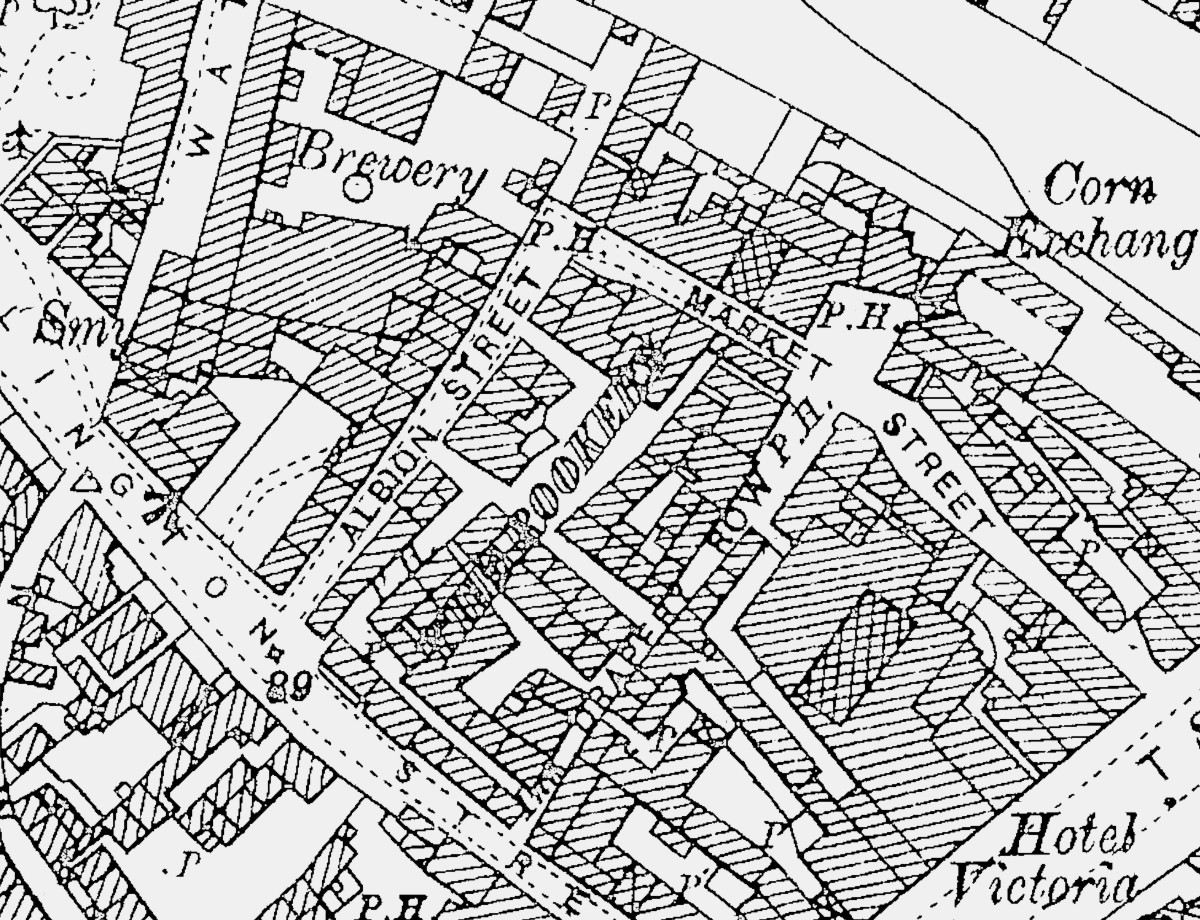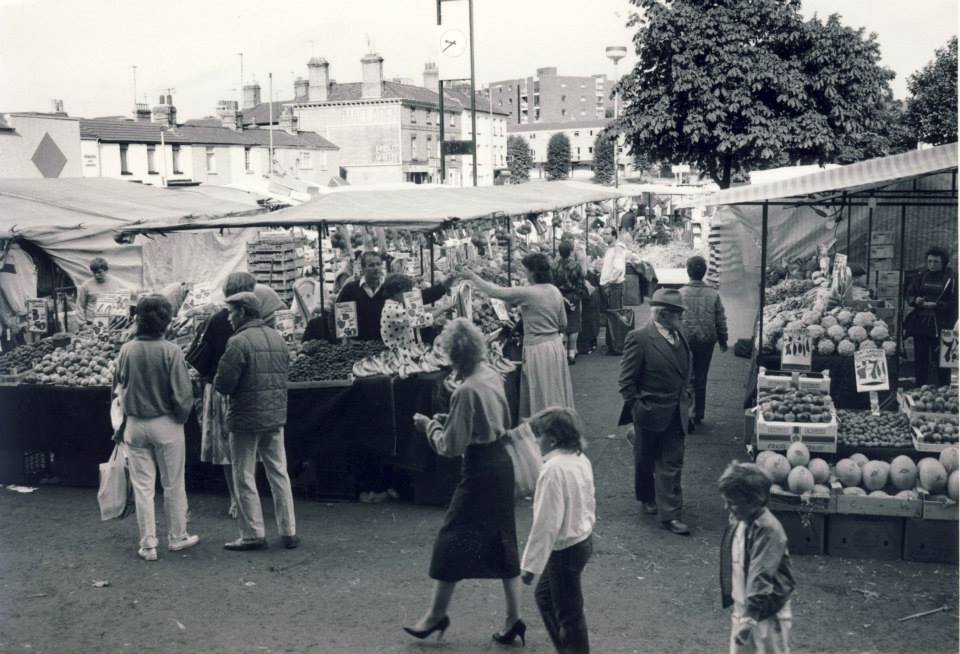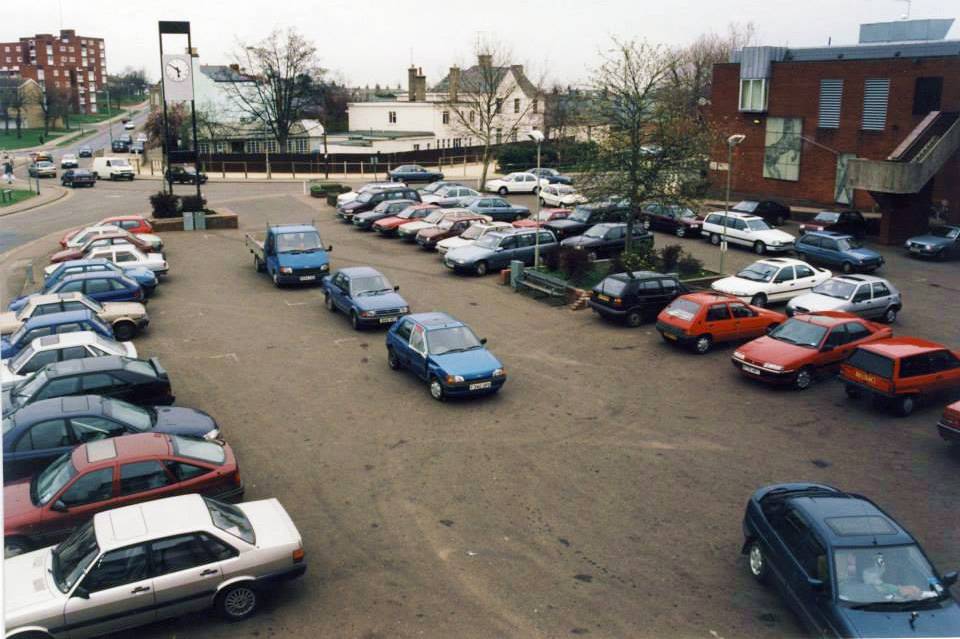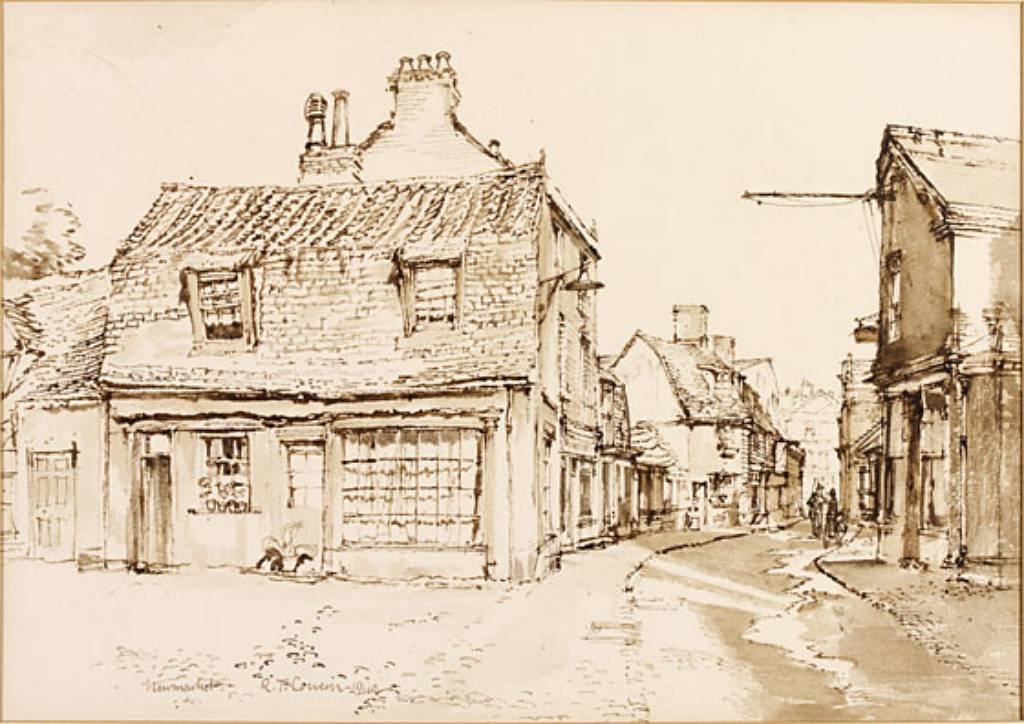The Rookery (now Guineas Shopping Centre) |

The Rookery Map 1901
Notes
- Known variously as the Rookery,
Shraggery, the Duddery
and even the the Butchery, this area of Newmarket
was a closely packed shambles of houses intermingled with a large number
of so-called 'Inns' (you have to remember that many of these
'Inns' were little more than a front room running on a 1/6 gin
licence - for example in the case of the wife of a soldier, to
provide an income so she could
keep herself fed and housed while he was away).
The name Duddery is derived from the Middle English word Dudde, meaning cloak, mantle or sackcloth (the words Dud, Dudley and Dodd have similar origins). Hence the word was used to describe a trading area for woollen drapers, wholesale tailors, and sellers of second-hand clothes - many existed around the country going back to the Middle Ages. With this in mind you'd think that Duddery was one of the oldest names for the area, but referring to local historical newspapers the name doesn't start to appear until the late 1850s and the first census which shows it was 1861 (the 1851 census for Newmarket St. Mary's is missing) - so either the name was simply used and not written down or it didn't come into common use until this time.
Shraggery has a similar meaning, and is a place where old clothes were sold - referring to the map below, in 1472 this name was associated with just one row in the area (It appears there's one other place in the country with a Shraggery and that's in Cambridge, so maybe this is a local name meaning?).
Although of course also meaning 'a breeding colony of rooks', in this usage Rookery was a colloquial term given in the 18th and 19th centuries for a dense collection of housing, i.e. a slum area ... with a very bad reputation. The area is called the Rookery in the 1841 census, so on that basis it appears to have been called the Rookery before it was called the Duddery.
Many thanks to the Newmarket Local History Society for the above 1472 map as produced by the Reverend Peter May. (copies of his book 'Newmarket Mediaeval & Tudor' can be purchased in bookshops and online)
The Market Place on Peter May's 1472 map of Newmarket
The Market Place on Chapman's 1787 map of Newmarket
Many thanks to Mike Mingay for the 1787 map.
- Key to 1472 map
Names in italics are tenantsKey Description in 1472 Present Address Notable recent use B The Watercourse New Cut C Market Lane Wellington Street 13 Ralph Gateward, Richard Gateward, Ralph Lote No.96-98 High Street Sheppards Grocers 14 John Leiston, Roger Holyngworth No.88-94 High Street 15 The Maidenhead: John Archer, Henry Dale No.84-86 High Street Simpson and Jeffery 16 William Mey, Christopher Roughe No.82 High Street The Carlton 17 The Sword: John Higham, Arthur Greysson, John Ayers, David Ayers No.78-80 High Street 18 The Pound: John Higham, Richard Gateward, John Bonde No.74-76 High Street Freeman hardy Willis 19 The Christopher: John Wright No.70-72 High Street Layngs / Whipps D Road to Cornhill Market Street E The Cornhill Corn Exchange F The Cross The pedestrian crossing 46 Bullsyard: John Wykes 47 Thomas Quylter, Ellis Jordon 48 John Kydde 49 Ralph Lote 50 Ralph Lote, Roger Holyngworth and John Cracke 51 The Fanfair: Simon Funston 52 Ralph Lote, John Kervin 53 Ralph Lote, John Grygge 54 Ralph Lote, Henry Dale 55 The Fanfair Way: Ralph Lote, John Glover 56 Bullsyard 57-58 The Fairway / Shraggery Row Guineas Shopping Centre Albion Street
- Both these maps and the main 1901 map at the
top of this page show the same area in Newmarket - so it's
interesting to see how the Rookery has changed over the years. Colloquially
in recent times the name 'the Dudderies' was mostly
associated with the western section of the area; the part that included the Lamb
Inn and Simpson's Printworks.
The Rookery was mostly the eastern area behind the Bushel.
- The Fox & Goose Lane, named after the Fox & Goose Inn,
became Wellington Lane and Wellington Inn in honour of Arthur
Wellesley, the 1st Duke of
Wellington and his success at the battle of Waterloo in 1815 and
then eventually
Wellington Street.
-
The Market Place
- Obviously with a name like Newmarket it's clear that the origins
of the town are closely tied-in with the origins of the market
itself. The full story of this plays out over quite a few centuries,
so we won't go into too much detail here, but for those interested
the full story can be read on the page for "The Origins of Newmarket"
(in outline the Market Charter was issued by King John sometime
around the year 1200).
Originally covering most of the area of the Rookery, the actual location of the market has moved over the years as shown on the main 1901 map at the top of this page. In 1787 the market was situated in the small area to the side of the Bushel and across in front of the Three Tuns. On a map dated between 1865 and 1882 (not shown here) the market had extended into the area in front of the Central Fish bar. These areas are shown in the etching below.
- As well as the street market, Newmarket also had a Corn Market (Corn
Exchange - visible on the above 1901 map) at the rear of the
Bull - No.62 High Street and
also a cattle market, entered into from the High Street at the side
of the Waggon & Horses -
No.34-36 High Street. The Corn exchange had a rear entrance that
entered onto the 1787 Market Place - which would have been just to
the far left on the above etching. At one time some of the market
stall holders used this area to store their stalls.

High Street Market Day
Photo by kind permission of the Newmarket Journal and the Newmarket Memories Facebook page.
- By 1904 the main market had moved to its better known location in the
High Street, and as can be seen in the photo above originally extended down both sides of the main
road. In more recent
times it had reduced to just the southern side of the High Street
and when the old Rookery was demolished to make way for the Rookery
Shopping Centre in 1974 the market was moved to the western side of
this, in the area between the King's Head
Brewery on the 1901 map above, stretching across to Wellington
Street.
The photos below show the new position for the market and also the 'infamous' Rookery Clock (if you refer to the 1901 map above, the clock stood where Murton's Butchers used to be). As well as telling the time, the clock face was supposed to rise and fall throughout the day ... it never did work properly, spending most of its time stuck in one place and even the clock's hands rarely worked. The clock was removed when the centre was extended in 1989 (see below for further details).
As can be seen above, on non market days the market square was, and is presently still used as a car park.
The Rookery Clock - 1977
- comment on this photo by Tony Pringle:-"I see they had already filled in the "pond" with cement*. That water feature must have been the very first change they had to make.
The square was still engineering bricks and slabs and not yet tarmac. They were told right from the start that the bricks and paving slabs would be no use. The lads who laid the slabs drank in the Bells while they were down here from Birmingham and they admitted they were not in the least bit worried about the speed and cheap way they laid them (dab of cement in each corner, one in the middle). it was the council dust cart that broke most of them in the end. Then of course it was tarmac and then re-done as there were puddles every where."
[*The 'pond' Tony refers to was a water feature that was initially located in that square brick plinth at the base of the clock.
Tony was the landlord of the Five Bells at the time - just across the road from here.]

Market Square c. 1980s
Photo by kind permission of the Newmarket Journal and the Newmarket Memories Facebook page.

Market Square c. 1980s - many thanks to 'Old Newmarket' for the above photo

Rookery Car Park and 'The Clock'
Photo by kind permission of the Newmarket Journal and the Newmarket Memories Facebook page.
Even more recently, due to various factors, including the financial crisis and online shopping, the market has reduced in size considerably and there's talk to move it again, hopefully with plans to revive some of its past importance .... as actually the market ought to be Newmarket's most major asset - 'how can you have a Newmarket without a market?'
-
Drapery Row / Dolphin Alley
- The name Drapery Row still exists today at its original location and
is used for the service access area that runs from Wellington
Street up to the Bushel. The article and sketching below shows
that at one time the lane was also called Dolphin Alley, oddly
though, as the sketching doesn't actually show the Dolphin Inn, which
probably referring to the 1901 map above is the
large chimneyed building right down the far end of the alley on
the right-hand side.
The name Drapery Row is used on all the censuses from 1861, but is not listed on the 1841 census - in fact with careful scanning through the addresses it appears to be being called Market Lane - which makes some sense as the market would have been at the near end of it, but it's a different usage of Market Lane compared to the 1472 map above.
-
The Bushel Inn / Bushell
-
The 1861, 1871 and 1881 censuses refer to this as the Bushell - slightly different spelling and no 'Inn'.
-
Barton's Greengrocers / Green Dragon
- Barton's greengrocers, with the 'Lyons Tea' sign on the wall, can
be seen in the postcard above just to the left of the Bushel Inn.
Chick Barton, the former grocer here, has several deeds mentioning the Green Dragon as the property next to the Bushel on Drapery Row.
- Suffolk Record Office, Bury St Edmunds Branch
Records of Messrs Ennions, Solicitors, Newmarket
Reference HB 517
5 messuages near the Market Place (one copyhold held of the manor of Newmarket to ?1852). [Wrapper refers to Duddery Cottages] HB 517/A/65 1774-1852
In 1774 described as messuage called the Green Dragon in the Butchery
Evidences of title for purchase by Samuel Westley of Newmarket (Cambs), builder from the trustees for sale under the will of his late father John Westley of Newmarket (Cambs) [farmer], 26 Jan 1848
- The Duddery Cottages referred to in
this historical record is the row of cottages on the right-hand side
of the above photos, that includes Barton's Greengrocers and also
maybe the Bushel Inn. It's interesting to
see this area also described as the 'Butchery' as this fits well
with the 'Shambles' description as detailed on the page for Market
Street, and in addition to those listed in later years for Market
Street the tradition for butchers in this area, notably Market
Place, can be seen in Slaters Directory of 1850:-
- David Bocock
- John Holmes
- Thomas Reed
- Norman Wiseman
 Market Street Cowen 1940 etching - many thanks to Tony Pringle for this etching |
 Dolphin Alley - also known as Drapery Row |
 Newmarket: its sports and personalities by Frank Silzter - page 118. Published 1923 |
 Shown in the recent picture above the service access road that leads up to the Bushel from Wellington Street is still called Drapery Row on the maps, but no street sign exists to let people know where this is. |
 Bushel Inn Postcard |
|
 Bushel Inn Sketch |
 Bushel Inn Postcard |
 The Bushel October 2010 |
|
Many thanks to Tony Pringle for the above sketch, postcards and photo.
 The Bushel Inn |
|

|

|
|
The Bushel
2013 |
|
 The Woolpack Inn - many thanks to Tony Pringle for the above photo |
-
As can be seen in the above photo, showing it's one-time
ownership, the pub sold Moody's Ales. For details about Moody's
brewery see the page for the King's
Head.
-
Woolpack History
| 1901 | James Hawkes | Census |
| 1891 | William Dunn | Census |
| 1881 | Henry Davey | Census |
| 1871 | Charlotte Jeffery | Census |
| 1861 | George Reynolds | Census |
| 1839 | Thomas Moody | Pigot's Directory |
-
The Dolphin Inn
-
-
The Fountain inn
- Suffolk
Record Office, Bury St Edmunds Branch
Newmarket Urban District Council Records
Reference EF 506 - Alterations to the Fountain Inn, Drapery Row, off Wellington St, for B. Chennell (Heaton & Gibbs) EF 506/6/1/G39 Sep 1896
-
The Duddery
-
The Lamb Inn
- Although in the above photo the yard on the right looks like it had
been closed-off by a wall and gate, at one time this had been the
Lamb Yard and was the heart of the Duddery. Even further to the
right and out-of-shot was the building that was used for many years
by Simpson's for their Printworks.
-
Lamb History
- Suffolk
Record Office, Bury St Edmunds Branch
Newmarket Urban District Council Records
Reference EF 506 - Additions to Lamb Inn, The Rookery, for William Cutlock & William Treadway EF 506/6/1/G39(a) Dec 1896
- Rebuilding portion of Lamb Inn, Rookery Yard, 'lately burnt down' EF 506/6/1/1/26 nd
-
Simpson's Printworks
- George Simpson had his shop at No.86-88
High Street and started printing the Newmarket Journal in 1872.
His printing office is shown in the Duddery in the 1891 census,
where it continued to be used up until the demolition of the Rookery
in the early 1970s, at which time the company was called Simpson and
Jeffery.
The photo below, taken in the early 1970s, shows the back of the shops in Wellington Street with H.J. Hawes Pork Shop the white building on the left hand side and Dolf's Ice Cream shop the one with the two first storey windows. Simpson's Printworks is the building on the right with the scooter in front and the lamp on the wall. The 1969 map, that can be seen on the page for Wellington Street, shows that the Printworks was the last building standing in the old Rookery, apart from the Bushel which is the only building that wasn't demolished and this row of houses in Wellington Street.

Rookery Car Park early 1970's - many thanks to 'Old Newmarket' for the above photo.
- [Note from webmaster - my claim-to-fame regarding the Printworks
is that while working for Anscomb's Photographers at No.156
High Street my uncle used to visit the Printworks for small
printing jobs, such as business cards. He remembers it being a
ramshackled building tucked in the corner of the old Rookery car
park.]
- It appears that the name 'The Duddery' has continued in just one
location in Newmarket - the Edinburgh Woollen Mill have it as part of their present address in the town.
Being at No.112 High Street the shop strictly isn't within the area that used to be called 'The Duddery',
but as actually the rear of their shop is only a few yards away from
the area and being a woollen clothing retailer their use of the name is highly appropriate.
-
Albion Street
-
Albion is an ancient Celtic name for Britain or England. The street extended from the end of Market Street down to Wellington Street.
-
Ernie Marsh
- The first shop in Albion Street, on the far left in the above
photo, will be remembered by many for its slightly risqué 'girlie
magazines' that could be seen in the shop window. Actually very
innocuous magazines, but slightly scandalous for the time, this was
Ernie Marsh's second hand book shop.
Not listed in the 1916 edition, but appearing in the 1925 Kelly's Directory, the 1923 planning detail below must be when Ernest Marsh opened his shop on the corner of Wellington Street, being listed as a news agent at that time.
Although very much in Albion Street the formal address of this shop was Wellington Street (Lane) and he's listed there in the 1926 Newmarket Street Directory and also in the 1936 directory, when it's listed as a book shop.
- Suffolk
Record Office, Bury St Edmunds Branch
Newmarket Urban District Council Records
Reference EF 506 - Alteration, shop window, corner of Wellington Lane and Albion St, for E. Marsh (Rodrigo Palethorpe) EF 506/6/1/18/640 Feb 1923
-
Wood & Rose Cycle & Repair Shop
- Wood & Rose Cycle Shop used to be in the one dead centre in the photo of
Albion Street above - their cycle repair shed had been directly opposite on the
other side of the road, but that other row of houses, including the Fire
Station, had been pulled down by the time this photo was taken
... all that's left is the stony ground in the foreground (curiously empty in this photo)
and this had been used as a
temporary car park (as can be seen in the late 1960s photo below).
In the 1936 Newmarket Directory Wood & Rose are listed in both No.2 and No.3 Albion Street, so that would suggest that the part of the building with the blue door would also have been theirs at that time. The door immediately to the left of the shop and presumably the upper storeys above appear to have been a private house called Derg House - lived in by Harry Butt in 1936.
- When the cycle repair shed was demolished the shop closed and
later became a bookmakers
-
Orby House
- Originally just a private house, in the 1911 census it had became
another of the Rookery's public houses. Occupied by Francis Albert
Pinn at that time, who lists himself as a 'Licensed Victualler' in a
hotel. His wife, Emily, had previously been the proprietor of
the Three Tuns in the 1904 Kelly's
Directory (see above).
Being right next door to the Sir John Barleycorn, Orby house it didn't last long as an inn and they don't appear in the 1916 Kelly's Directory.
Interestingly, in September 1916 during WWI, a 33 y.o. Frank W. Bin gave his home address as Orby House, Newmarket while being detained in Ruhleben Internment Camp near Berlin, Germany. Ruhleben was a civilian prisoner-of-war camp and was originally a harness racing track. Frank gave his occupation as a Jockey. Francis' son was called Walter Francis Pinn, he was actually 36 in 1916, but it doesn't need too much imagination to see that he'd probably swapped his Christian names around and along with a misheard surname, Walter Francis Pinn became Frank W. Bin.
This must have been a very worrying time for Francis senior and being 68 it's most likely that he simply retired from being an inn-keeper.
He died four years later in Newmarket in December 1920. Emily re-married to Henry Terry Shoesmith Avis in 1923 and they're shown living in Orby house in the 1926 Newmarket Street Directory. Born in 1856 in Withyham, Sussex, more recently Henry T.S. had been living in Sevenoaks, Kent, where in 1911 he was listed as a 'Retired Licensed Victualler' - clearly there'd been some licensee trade link with Emily.
It's known from other sources that Orby House became a cheap lodging house and between 1928 & 1930 a Captain Raymond Albert Lawrence Winfield-Chislett, "Genuine Turf Correspondent", lodged at Orby House in Albion Street.
Henry T.S. Avis died in Dec 1935, Emily was still living here in the 1936 Directory. By the 1940s it's beloved the house had been demolished and the plot was being used as a garage. Just before the Rookery was demolished in 1974 there's just a lean-to shed at this location, as can be seen in the photo below.
- [Note from webmaster - Orby House is shown on the 1901
map above as being where the 'shed' is in the photo below, but
there may be a more likely location. On all the censuses and
directories that the house is listed on, it's always shown as being
immediately adjacent to the Sir John
Barleycorn in Albion Street (i.e. where the 'shed' is).
Looking at this picture though there may be a more likely interpretation for the location of Orby House - as being the slightly exotic building(s) on the left of the photo, to the left of the 'shed' - both the twin-arch-fronted lean-to and the white-washed main building. These do like that they were more likely to have been part of a lodging house.
On the various censuses there's always a few more names listed next down from Orby House in Albion Street - more than the remaining number of buildings actually in the street - the reason for this could have been that they were sub-lets of an overall Orby lodging house.
If anyone can 'shed' (pardon the pun) more light on this please E-MAIL me - it may be that the 'shed', is just a shed.]
-
Sir John Barleycorn / Cock
- The Sir John Barleycorn can be seen in the above late 1960s photo,
just to the left of Hunter & Oliver's wine merchants. Clearly
looking very derelict at that time, the pub seems to have closed
sometime around 1925 - it's listed in Kelly's Directory for that
year but is not shown on the Newmarket Street Directory of 1926.
-
King's Head Brewery
- Originally located on the High Street at No.92-94
the King's Head was originally just a public inn. Converting to a
brewery it moved sometime after 1865 to a custom-built building on
the corner of Albion
Street where it joined Market Street, with trade being carried on by the Moody
family. Full details about the brewery can be found on this page - The
King's Head.
-
Two Old Brewers
-
Fire Station
-
It's believed that this is the earliest incarnation of the Newmarket
Fire Station. It later moved to No.22
Rous Road. As can be seen in this photo and also listed in the
1936 Newmarket Directory this had been the office of the Evening Standard.
-
The single storey building further along the row on the
right is Wood & Rose Cycle Repair
shed, their cycle shop was directly in front of this on the
other side of the road.
-
Albion Stores / Pelican
- Suffolk
Record Office, Bury St Edmunds Branch
Newmarket Urban District Council Records
Reference EF 506 - Rebuilding Albion Stores, Albion St, for Lacon & Co (John Flatman) EF 506/6/1/4/185 nd (1899)
- Alterations and additions to the Albion Stores, Albion St, for Lacon & Co (John Flatman) EF 506/6/1/4/192 Jun 1899
-
1950s Rookery
- The aerial photo above, taken in the 1950s shows that the Rookery
was becoming increasingly derelict by that time. The main building
of the King's Head Brewery had
been demolished, though the brewery yard is still clearly visible.
Next to this the Sir John Barleycorn
building is still there as is most of the houses on both sides of Albion
Street.
The central Rookery and Duddery yards are looking pretty sparse and most of Drapery Row has gone, leaving only Barton's grocers and the Bushel Inn. You can see the white Three Tuns building in the foreground and just to the left of this the tall Alma House, though this and all the other buildings around it are dwarfed by the Carlton Hotel, between the Rookery and the High Street.
-
End of the old Rookery
- The 21st September 1972 public planning document below details the closing of the
streets that formed the historic Rookery. From that time the
Rookery, Duddery and all its tiny streets became a 'no-go' area ...
to be later re-opened on Tuesday March 11th 1975 as the Rookery Shopping Centre.
Gone were the shambles of streets that had evolved over the centuries, which had decayed to become untenable, to be replaced by a bright modern shopping centre.

By this time the old Rookery had been allowed to become seriously derelict ... but there are numerous Newmarket residents who desperately bemoan the loss of this quaint and unique artefact of a long-gone part of Newmarket's rich history. There's also a strong opinion that the planners of the time should have followed the excellent example of 'The Shambles' in York, and refurbished the buildings, to create a thriving shopping community and as with York, a major tourist attraction - an opportunity lost!
The only parts of the former Rookery that remain today are the Bushel and the shops in Market Street.
The large tract of land to the east of the shopping centre up to Exeter Road became an open car park, surrounded by a service road that exited onto a new highway between Exeter Road and Wellington Street - Fred Archer Way - named in honour of the famous Newmarket jockey - details about him can be found here.
In 1989 the shopping centre was extended even further, to remove part of the service road and cover half of the open air car park. The other half of this area also changed to be replace by the present multi-storey car park.
Original Rookery Car Park late 1970s
- the entrance on Exeter Road
Photo by kind permission of the Newmarket Journal and the Newmarket Memories Facebook page.

Original Rookery Car Park 1977
- looking out from the shops

Rookery Shops 1977
No.1 - Delicatessen
No.2 - Frances
No.3 - Garden Gate Flowers
No.4 - Hot Bread Kitchen
No.5 - Darling & Wood Television
No.6 - The Prohibition

The Rookery Shopping Centre
Photo by kind permission of the Newmarket Journal and the Newmarket Memories Facebook page.
In early 2010 the centre was placed in administration and was subsequently purchased by Helical Bar, a property development and investment company, for £17.75m.
The centre was renamed the Guineas Shopping Centre and presently covers 133,000 sq. ft.
The building that houses the medical centre is the only part that continues the original name - Rookery Medical Centre, Rookery House.

There are still plans to extend the centre even further and cover the open market area, but with the financial downturn no work has commenced as of yet. Planning permission for this was submitted in 2007, granted in 2008 and was then given a 3-year extension in 2011. This year, 2014, is clearly the year-of-decision ... so we'll have to wait and see what will become the fate of the present market ...
'the reason for the name of the town - Newmarket'.
-
In July 2014 the Guineas Shopping Centre was sold by Helical Bar to Phoenix Life Ltd., part of Phoenix Group Holdings, for £18.3 million, a rise of three per cent since its acquisition from administrators on behalf of Lloyds Bank in 2011.

http://www.cambridge-news.co.uk/newmarkets-guineas-centre-bought-for183-million/story-22770856-detail/story.html
- Return to top of page
 The Lamb Inn - many thanks to Peter Norman for the above photo |
| 1913 | sold unlicensed | Newmarket Journal |
| 1911 | Emma Dyson, unlicensed lodging house | Census |
| 1904 | Dyson, Harry, beer retailer, Drapery Row | Kelly's Directory |
| 1901 | Henry Dyson | Census |
| 1896 | Harry Dyson | Kelly's Directory |
| 1892 | Dyson, William Henry, Lamb, Drapery Row | Kelly's Directory |
| 1892 | Harry Dyson | Tindall's Directory |
| 1891 | Henry Dyson | Census |
| 1887 | John Lawrence, on death passed to wife Julia | Newmarket Journal |
| 1885 | Jacob Coe | White's Directory |
| 1879 | Coe, Jacob, Lamb, Drapery Row | Post Office Directory |
| 1873 | Jacob Coe | Harrod's Directory |
| 1871 | Jacob Coe | Census |
| 1869 | Coe, Jacob, Lamb, Wellington Lane | Post Office Directory |
| 1865 | William Eley | Post Office Directory |
| 1861 | William Eley | Census |
| 1855 | John Palmer, Lamb, Market Lane | White's Directory |
| 1844 | John Frost | White's Directory |
| 1839 | Dyson, William | Robson's Directory |
| 1839 | William Dyson | Pigot's Directory |
| 1830 | Henry Green | Pigot's Directory |
| 1823 | Thomas Green | Pigot's Directory |
 Albion Street c.1970s - many thanks to Peter Norman for the above photo (click on the picture for a larger image) |
 Rookery Car Park late 1960s - many thanks to 'Old Newmarket' for the above photo. |
 Hunter & Oliver Wine & Spirit Merchant c.1948 - many thanks to 'Old Newmarket' for the above photo. |
 The early Fire Station in Albion Street c. 1930's - many thanks to 'Old Newmarket' for the above photo. |
 Rookery aerial view 1950s - many thanks to Mike Mingay for this photo. (click on the picture for a larger image) |